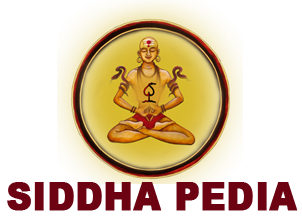Kankala Bhairava
Kaṅkālā Bhairava Tantra is regarded as one of the most profound and important tantras in Siddha Dharma. Kaṅkālā Bhairava is the hidden, sustaining, and awe-inspiring form of Shiva—the skeletal ground of existence, the essence behind creation, sustenance, and dissolution, and the fearless truth that underlies both the cosmos and human life.
Kaṅkālā (कङ्काल) means skeleton, bare bones, Bhairava (भैरव) means the fierce, awe-inspiring form of Shiva and Tantra (तन्त्र) here means the system or process of Kaṅkālā Bhairava.
Kaṅkālā Bhairava Tantra is one the hardest sadhana practice and often done by great accomplished tantrikas.
Kaṅkālā Bhairava Tantra is one the three-scripture manuscript on Kaṅkālā Bhairava. Apart from it, there is the Kaṅkālā Kalpa and Guhya Kaṅkālā Tantra manuscript.
Etymology
Contents
Because Shiva wears the kaṅkāl of Maa Shakti, He thus became Kaṅkāla Bhairava. He wears only the skulls of Goddess Pārvatī around His neck and Himself becomes the skeleton. Everything that Shiva revealed in this Kaṅkāla form became part of the Kaṅkāla Bhairava Tantra.
Maha Siddha Adi Hiranyagarbha Nath composed the three manuscripts on Kaṅkāla Bhairava. He had stopped eating and drinking and became like kankaal. He then meditated on Bhagwaan Shiva. Shiva saw that his devotee has become kankaal. And thus, Shiv also took Kankal form. And asked if he likes this form, and then when Maha Siddha Adi Hiranyagarbha Nath said otherwise, Shiva asked him to eat food and thus with blessing restored form.
When Maa Pārvatī received this knowledge, she observed that the skeletal body was piled up without a skull, since the skulls were already part of the necklace around Shiva’s neck. The Goddess then picked up one bone and inscribed a manuscript of wisdom upon it. This act became a precedent, and thereafter many great Siddhas began preserving manuscripts and secret knowledge within skeletal forms. They also created bone-like shapes from metals and etched the names of the Goddess upon them as part of their ritual practices.
Bhairava represents Shiva as the master of the two primal instincts—fear and desire. These instincts, implanted by Bhagawati Yogamaya, keep humans bound to her system. The fear of death is the most primal of these, deeply ingrained to ensure that we remain within her cycle and do not transcend toward the Kaṅkālā Tattva of Shiva.
When a person realizes this Kaṅkālā Tattva, they break free from the veil of Shakti Tattva—a breakthrough that Bhagawati’s system resists. Kaṅkālā Bhairava therefore represents the fierce Aghora aspect of Shiva: a tantra that cuts through illusion and aims at ultimate liberation.
Iconography
Kaṅkālā Bhairava is depicted seated in a realm filled with bones and skeletal remains—not only of humans and animals, but also of strange and unknown beings, even including the decayed trunks of trees. Upon this bed of skeletons, Bhagwatī lies, while above her stretches a sky covered with clouds. On top of these clouds, Kaṅkālā Bhairava stands in Vīra Mudrā, with one leg stretched outward in commanding power.
He wears only a small piece of deer skin, is adorned with a mālā of 108 bones, and displays his three eyes blazing with fierce awareness. His body reveals visible nerves and veins beneath the skin, emphasizing his skeletal form. Kaṅkālā Bhairava wears skull-shaped earrings and a crown of five skulls, while the half-moon is placed upon his head.
He is shown with four arms, holding a a khaḍga (sword), skull bowl khappar, a human skeleton, and an animal skeleton. His mouth reveals sharp canine teeth, adding to his terrifying yet awe-inspiring presence. There is fire shown blazing behind him. His skin tone is reddish.
Meditating on such a form, destroys fear of death, disease and suffering.
Origin
As per Siddha Dharma, once when Lord Shiva, as Swachhanda Bhairava, and Ma Parvati, as Aghoreshwari Kurukulla, were engrossed in a deep conversation on Agama and Nigama in Kailasa, she inquired of her Lord:
“You are the Lord of death and annihilation, and people know you through unpleasurable names. The good things have been allocated to the Devas and other deities, but to you has been given the unpopular and unpleasurable sobriquet. Does this not offend you, even a little? The other deities wear ornaments and jewelry, while you wear a garland of skulls.”
The Lord replied that he was not offended in the least. The other Devas and deities, who have been ordained with pleasurable duties, function under the delusion of Bhagawati Yogamaya. All their actions pertaining to their work and duties are nothing more than a great leap into delusion. They are devoid of the naked truth, acting out of a romantic perspective infused in them by Yogamaya.
“But since you are Aghoreshwari and I am Aghoreswara, we should embrace the naked truth of the universe; therefore, we should not be offended. I am the truth, and like me, the truth is also unpleasant. Truth—unlike the beauty of Maya—is not skin-deep, but rests upon Kaṅkālā.”
Hearing these thought-provoking words of Bhairava, she asked her Lord to show her the naked truth, by the cognizance of which he remained in bliss despite being labeled with unpleasurable names.
He then asked her to close her eyes. Taking her into another dimension, he revealed a universe where there was no light, nothing above or below, nothing near or far—only shining Kaṅkālās everywhere. He explained to her that this was the inception point of the universe and that these Kaṅkālās were the foundation of all existence. Even light itself was composed of Kaṅkālā.
She was dismayed and confused. The Lord then clarified that all these Kaṅkālās represent the final stage before attaining the ultimate stage. He would now take her further.
By his yogabala (yogic power), the Kaṅkālās began to slowly dismantle into small pieces and particles, floating throughout the universe. After some time, these fragments fused and combined with each other.
He explained that he was not dismayed by labels because he is the truth, and all Kaṅkālās are none other than himself. As the Kaṅkālās fused, they formed a great Kaṅkālā in the shape of a human skeleton. The skeleton was covered only by skin, with sunken abdomen and cheeks, appearing frightening, holding a skull-cap in his hand.
“This Bhairava,” he explained, “is Kaṅkāla Bhairava. This is my original form. All the Kaṅkālās in this universe are me, and together they form the universe. You too play an important role in this creation.”
She then inquired further. Suddenly, a divine light of Yogamaya emitted from her body and united with Kaṅkāla Bhairava. Instantly, he was transformed—from the skeletal form into a beautiful body, as Bhagawati added aesthetics to the naked truth of Kaṅkālā.
The transformation was so striking that all creation stood in awe. The Devas were stunned, and even the pushpavana (flower bow) of Kamadeva was released. The Devas unanimously agreed that they had never seen such beauty before.
Shiva explained: “The aesthetics and beauty in me is Shakti herself. But the naked truth hidden inside Shakti is me. The play of you and me, Shiva and Shakti, is the cause of origin, maintenance, and dissolution of the universe.”
Devi then observed the universe from an eagle’s view, seeing many Swachhanda Bhairavas and herself across different realms, with various Devas absorbed in their activities. She asked the fate of these observed realities.
The Lord replied: “They have no future; they are but reflections in the present moment. The day they cease to reflect, they become one with me. When reflected, they develop ego under the influence of Yogamaya and ignorance, thinking they know everything and can redeem themselves. But only I can redeem them from Maya, for I am the progenitor of this universe.”
He further explained that the wisdom of her many births was hidden in the 108 Kaṅkālās he wore as a garland.
They then meditated upon the Kaṅkālā. Her head was transformed into a Kaṅkālā, her skin stripped, though her beautiful body remained intact. The head separated from her body, and when Shiva embraced it, it became part of his garland. A new head emerged, and the process continued until 108 heads adorned him.
He explained: “I wear this garland of Kaṅkālās or Muṇḍamālā because I embrace the naked truth that no one else wishes to accept. Because of your playful nature, your reflection in the creation’s mana (mind), chitta (consciousness/memory), buddhi (intellect), and ahaṅkāra (ego), my real form remains hidden. Thus, creation belittles me and criticizes me, unaware of the ultimate. You, as Yogamaya, hide beneath the veil of aesthetics, but I am the naked truth. I remain unclothed, and for this reason, deluded beings avoid embracing me.”
The Devi then held her 109th head and offered it to him. The Lord replied: “I do not need it, for the whole wisdom of the universe has already been bestowed upon you by me. The wisdom of the universe is confined within these 108 skulls. You must now explain your system through your own words.”
Bhagawati then transformed into her Aghoreshwari form. Her beauty vanished, and she became a dark and terrifying figure. Expanding into her Virāṭ Svarūpa, she appeared with disheveled hair, elongated nails, and a funeral pyre burning behind her. Her canine teeth reached her navel, and hair erupted from her body like animals. Her aesthetics disappeared.
Her tongue grew long, stretching outward and then retreating. As her tongue withdrew and she attempted to address Bhairava, her words became the mantras of Kaṅkāla Bhairava. Among the 108 mantras revealed to Siddha Dharma by Mahāsiddha Koshira Nath Ji, one is as follows:
Mantra:
सकक्कक्वचक्वल्लक्वछक्वेक्वल्लभेशकश्वेकककंकंकंके हरर्रहरर्र कंकाल भैरवाय शव्यशरररररैं भं भे प्रचट-चट क्वल्वकणिकिटकिटतथं थे हुं फट।
Transliteration:
Saka-kka-kva-cakva-lla-kva-chakva-e-kva-llabheśaka-śve-kakakaṁ-kaṁ-kaṁ-ke hararra-hararra kaṅkāla-bhairavāya śavya-śararararaṁ bham bhe pracṭa-caṭa kvalva-kaṇikiṭikiṭa-tathaṁ the huṁ phaṭ.
Lord Narayana, witnessing the ever-expanding Aghora Leela, saw that its boundlessness might destabilize the universe. To preserve creation, he plucked three petals from his lotus and released them toward Shiva and Shakti. These three petals elongated and veiled the entire leela of Shiva and Shakti.
Thus, this vidyā came to be known as Tri-Patra Vidyā—“Three-Petal Knowledge”—which covers the triad of:
- Kaṅkāla Bhairava
- the Aghora Virāṭ Svarūpa of Yogamaya
- the divine play of the Devas.
Lord Narayana is considered the progenitor of this vidyā in Siddha Dharma, for through these three petals the entire scenario was hidden from rishis, munis, siddhas, and others.
When Swachhanda Bhairava and Ma Aghoreshwari Kurukulla returned to their original forms in Kailasa, Lord Narayana appeared and presented the three lotus petals to Ma Kurukulla, as the vidyās hidden within them belonged to her. She accepted the petals, and in the future, whenever she bestowed this knowledge upon rishis, munis, and siddhas, she would be depicted holding three lotus petals. Thus, the Kaṅkāla Bhairava Tantra is founded upon the wisdom contained in these three petals.
Philosophy of Kaṅkālā
According to Siddha Dharma, multiple philosophical schools are tied to Kaṅkālā Bhairava, with Nāstika traditions being especially influential. The Kaṅkālā Bhairava Tantra explores the supreme essence of existence, even resonating with Astitvavāda (existentialism).
It has also inspired nihilistic interpretations: that the ultimate end of both human life and the cosmos is nothing but skeleton—the bare foundation stripped of all coverings. Because of these wide-ranging interpretations, Siddhas themselves hold divided views on the philosophy of Kaṅkālā. No single perspective is universally accepted.
The main philosophical threads include the following:
Nāstika Philosophy
As per Siddha Dharma, the Kaṅkālā Bhairava Tantra falls under hardcore Nāstika Darśana (atheistic philosophy). It negates or rejects romanticized perspectives of the universe and creation.
The Tantra perceives the end of the universe to be nothing more than a Kaṅkālā, and that Kaṅkālā itself will eventually be reduced to ashes. Hence, Shaivas smear ashes over their bodies, symbolizing that in the end, nothing remains in this universe. There may be countless cycles of creation and dissolution, but at the very end of this cycle, everything first becomes Kaṅkālā and then ashes.
The ultimate fate of creation is nothing more than the reduction of the infinite universe into a handful of ashes.
Hardcore Astitvavāda (Existentialism)
The Siddha Dharma also holds that the Kaṅkālā Bhairava Tantra is deeply existential in its approach because its geist is about the “essence” of our existence.
Existence is always defined by an essence. Essence is the foundational base of any entity. We call ourselves humans because we fulfill the essence of being human. Had we fulfilled the conditions of animal essence, we would have existed as animals.
At any given time, under any conditions, we humans are nothing but walking, talking, social Kaṅkālās. Our aspirations, dreams, and pursuit of happiness or pleasure exist only because of Māyā. We are deluded by Māyā and define our existence through our own thought processes.
But from a realistic point of view, we are Kaṅkālās, deluded by Māyā so as not to contemplate the darker side of our existence. Māyā paints a bright picture of our existence, distracting us from its core reality.
The Kaṅkālā Bhairava Tantra is about dismantling this romantic delusion and bringing it down to its foundational core.
Nihilism (Nāsa-vāda)
The Siddha Dharma also perceives the Kaṅkālā Bhairava Tantra to be nihilistic (nāsa-vāda) in its approach. If the essence of the universe is nothing more than Kaṅkālā, and if even Kaṅkālā must ultimately be reduced to ashes, then what is the final truth of the universe?
The Kaṅkālā Bhairava Tantra states that Kaṅkālā is the final truth.
Furthermore, the Tantra rejects the authority of the Vedas. It does not recognize the Vedas as the ultimate essence of the universe. The Tantra believes that truth is more naked than the Vedas and transcends them.
Aghora Perspective
Fundamentally, the approach of Lord Shiva in explaining this Tantra to Ma Pārvatī is Aghora in nature. Their līlā is also Aghora in character, as Shiva rejects all forms of hypocrisy and romanticized views of the universe, bringing Ma Pārvatī face-to-face with the naked truth of existence.
The Kaṅkālā Bhairava Tantra therefore eulogizes Lord Viṣṇu as the progenitor of this Tantra, because he was the one who placed a veil over the līlā of Shiva and Shakti with his three lotus petals.
No Uniform Concept
The perspectives above outline different subjective perceptions. Therefore, there is no uniform or singular concept of the Kaṅkālā Bhairava Tantra. Siddhas hold divergent views—both Nāstika and Āstika—regarding its philosophy.
Rejection of the Authority of Vedas
According to Siddha Dharma, the Kaṅkālā Bhairava Tantra is a hardcore Shaiva doctrine that rejects the authority of the Vedas. The word Veda means “to know,” but the Tantra maintains that there is nothing more to be known in this universe than Kaṅkālā itself—and the Vedas do not speak of it.
All doctrines in the world are nothing more than romanticized perceptions and thoughts built on the foundation of Shakti or Māyā. There is no truth beyond being Kaṅkālā.
Rejection of Individual Consciousness
The Siddha Dharma also teaches that Kaṅkālā Bhairava rejects the notion of individual consciousness or ātman in humans. This is a hardcore truth, though unpleasant to hear.
There is only Shiva, and the world is his reflection. If anyone perceives themselves to have an individual ātman, they are deluded by Māyā and will ultimately be deceived—subtly yet thoroughly.
Rejection of Mainstream View of Mukti
The Kaṅkālā Bhairava Tantra also rejects the mainstream understanding of mukti (liberation). While explaining the Tantra to Ma Kurukullā, the Lord reiterates that the conventional view of liberation is rooted in Shakti’s delusion and not founded on naked truth. Even when a person attains mukti, it is only momentary.
The ultimate redemption and freedom can only be bestowed through his Kaṅkālā Bhairava form. He declares to Ma Kurukullā:
“I am the redeemer of all redemption.”
For:
- the world is redeemed into Kaṅkālā,
- Kaṅkālā is redeemed into ashes,
- and the ashes are finally redeemed by himself, as he smears them upon his own body.
There is no truth above or below him, and no redeemer beyond him.
The Three Lotus Petals
In Siddha Dharma, the teaching of the three lotus petals—used by Lord Viṣṇu to veil the līlā of Shiva and Shakti—forms the basis of this Tantra. These three petals symbolize three upward-facing triangles, known as the Shiva Trikoṇa. The Kaṅkālā Bhairava Tantra rests upon this triadic foundation.
The three lotus petals can be interpreted in various ways. One of the key interpretations is that the three lotus petals represent the three fundamental nāḍīs: iḍā, piṅgalā, and suṣumṇā.
These three nāḍīs conceal the inner Shiva and Shakti tattva. If a Siddha succeeds in unlocking human existence through mastery of these three nāḍīs, the Siddha can also unlock the deeper answers to both the universe and human existence itself.
In ordinary understanding, life is usually perceived in two petals:
- Saṁsāra (materialistic life)— linked to aparā śakti.
- Para śakti— subtle, unseen, and transcendent.
However, beyond these two lies parāparā, the third state that surpasses both.
Often parāparā is seen as a combination of both parā and aparā. But in the Kaṅkālā Bhairava Tantra, parāparā is regarded as an independent third state.
This state includes the qualities (guṇas) of both parā and aparā, while simultaneously embodying the qualities of that which lies beyond them.
In many traditions, Parāparā is seen merely as a combination of both Parā and Aparā. However, in the Kaṅkālā Bhairava Tantra, Parāparā is understood as an independent third state—not just a blend, but a distinct realm of being.
- It contains the guṇas (qualities) of Parā(transcendent) and Aparā (material),
- Yet it also includes the qualities of that which lies beyond both.
Thus, Parāparā is the bridge-state: both immanent and transcendent, yet also the doorway to what surpasses dualities entirely.
Kaṅkālā Bhairava and Kaṅkālā Murti
According to Siddha Dharma, during the Vāmana Avatāra, Lord Viṣṇu subdued the daitya king Mahābali, who had grown so powerful that he was causing havoc in the universe. At one point, Viṣṇu realized that the immense power within him had gone beyond his own control. Concerned, Viṣṇu and the Devatās prayed to Lord Shiva to help subdue the overwhelming energy that had arisen.
In response, Lord Shiva manifested the form of Kaṅkālā Mūrti from his Kaṅkālā Bhairava form. The Kaṅkālā Mūrti, with its divine abilities, concentrated the inner Śakti (Kuṇḍalinī) of the Vāmana Avatāra around the spine. Through this immense yogic power, Shiva extracted the spine from Vāmana, causing him to revert back to his original form.
This is why Kaṅkālā Mūrti is often depicted holding a bone-club in one hand—symbolizing the spine of Lord Vāmana Avatāra, and serving as a reminder of the divine energy that was harnessed by Shiva to restore balance to the universe.
Mahasiddha Ishaputra and Kaṅkālā Bhairava Tantra
The teachings of Kaṅkālā Bhairava Tantra are deeply revered by the Siddhas of Siddha Dharma. A notable instance of its significance occurred when Mahāsiddha Iśaputra, along with his spiritual brothers, underwent the test to become the head of the Kaulāntak Peeth. During this examination, the Gurumaṇḍala posed seven questions specifically on the Kaṅkālā Bhairava Tantra. Whether by coincidence or divine design, the focus of these questions was unmistakably centered on this powerful Tantra, underlining its profound importance within the tradition.
Important Gurus of Kaṅkālā Bhairava Tantra
According to the Siddha tradition, Ādi Hiraṇyagarbha Nāth Ji first obtained the Kaṅkālā Bhairava Tantra directly from Lord Shiva. After him, many Mahāsiddhas carried this knowledge forward. Among them, Mahāsiddha Kosher Nāth Ji played a pivotal role by refining the teachings and adding the samput of Deva Dharma. Because many practitioners found the original methods difficult to follow, he also simplified the practice for wider transmission. In total, eighteen Mahāsiddhas took this lineage forward—sixteen Āstika Mahāsiddhas (aligned with Vedic Dharma) and two Nāstika Mahāsiddhas (outside the Vedic fold).
| SL No. | Image | Name of the Mahasiddhas (English) | Name of the Mahasiddhas (Hindi) | |
|---|---|---|---|---|
| 1 | 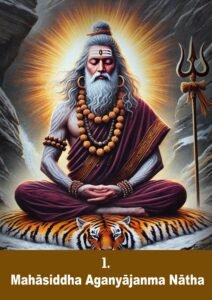 | Mahāsiddha Aganyajanma Nātha | महासिद्ध अगण्यजन्म नाथ | ब्रह्मसिद्ध |
| 2 |  | Mahāsiddha Dharmalohita Nātha | महासिद्ध धर्मलोहित नाथ | ब्रह्मसिद्ध |
| 3 |  | Mahāsiddha Vamakharpari Nātha | महासिद्ध वामखर्परी नाथ | ब्रह्मसिद्ध |
| 4 |  | Mahāsiddha Vajraheeraka Nātha | महासिद्ध वज्रहीरक नाथ | ब्रह्मसिद्ध |
| 5 | 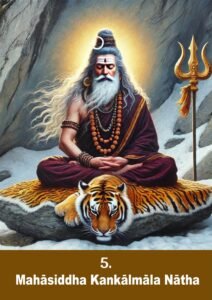 | Mahāsiddha Kankaalmaala Nātha | महासिद्ध कंकालमाल नाथ | ब्रह्मसिद्ध |
| 6 |  | Mahāsiddha Vivswana Nātha | महासिद्ध विवस्वान नाथ | ब्रह्मसिद्ध |
| 7 | 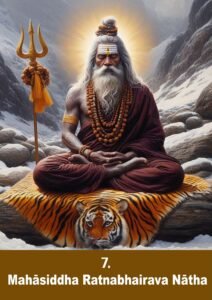 | Mahāsiddha Ratnabhairava Nātha | महासिद्ध रत्नभैरव नाथ | ब्रह्मसिद्ध |
| 8 |  | Mahāsiddha Mashanmushthi Nātha | महासिद्ध मशानमुष्ठि नाथ | ब्रह्मसिद्ध |
| 9 |  | Mahāsiddha Atichhatra Nātha | महासिद्ध अतिछत्र नाथ | ब्रह्मसिद्ध |
| 10 | 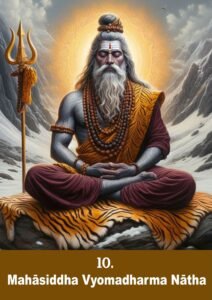 | Mahāsiddha Vyomadharma Nātha | महासिद्ध व्योमधर्म नाथ | ब्रह्मसिद्ध |
| 11 | 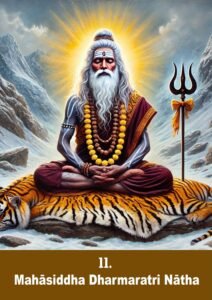 | Mahāsiddha Dharmaratri Nātha | महासिद्ध धर्मरात्रि नाथ | ब्रह्मसिद्ध |
| 12 | 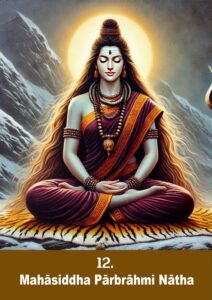 | Mahāsiddha Paarbrahmi Nātha | महासिद्धा पारब्रह्मी नाथ | ब्रह्मसिद्ध |
| 13 | 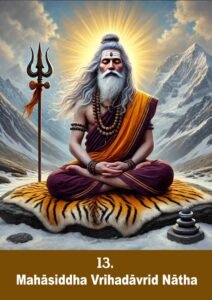 | Mahāsiddha Vrihadavrid Nātha | महासिद्ध वृहदावृद नाथ | ब्रह्मसिद्ध |
| 14 | 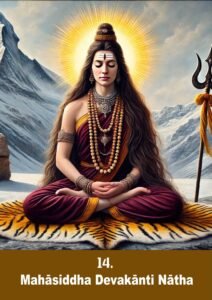 | Mahāsiddha Devakanti Nātha | महासिद्धा देवकांति नाथ | ब्रह्मसिद्ध |
| 15 | 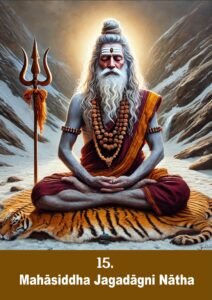 | Mahāsiddha Jagadaagni Nātha | महासिद्ध जगदाग्नि नाथ | ब्रह्मसिद्ध |
| 16 |  | Mahāsiddha Atikrishna Nātha | महासिद्ध अतिकृष्ण नाथ | ब्रह्मसिद्ध |
| 17 |  | Mahāsiddha Mahiraksha Nātha | महासिद्ध महिरक्ष नाथ | द्रव्यसिद्ध |
| 18 | 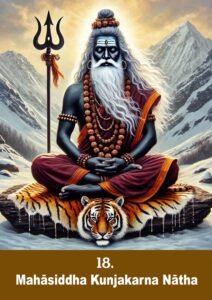 | Mahāsiddha Kunjakarna Nātha | महासिद्ध कुञ्जकर्ण नाथ | द्रव्यसिद्ध |
Kaṅkālā Bhairava Tantra Maṇḍala
The yantra of Kaṅkāla Bhairava is considered one of the most intricate maṇḍalas in Tantra. Unlike many other yantras, it has no outer circle enclosing its design. The structure begins with a Sahasrakona—a figure of one thousand edges. Within this, there are three concentric circles, and inside them appear five rectangular enclosures.
At the next level, another Sahasrakona of one thousand edges is drawn, followed by a ring of one thousand lotus petals. Deeper within lies the bhūpura (square enclosure), leading into successive layers of lotuses: first 64 petals, then 33 petals, followed by 16 petals, and then 8 petals.
At the very center rests the Ūrdhvamukhī Triśūla-triangle (three upward-facing Shiva triangles), and at its innermost heart shines the bindu, the point of ultimate essence.
The Four Mandalas Around
Surrounding this central structure are four important maṇḍalas:
- On the top right resides the Guru Maṇḍala.
- On the top left resides the Deva Maṇḍala.
- On the bottom right is the Nāga Maṇḍala.
- On the bottom left is the Ḍākinī Maṇḍala.
The Utkilaka Śakti (the unlocking force of this yantra) is Dhūmāvatī. However, the full yantra is not revealed publicly. There are many hidden aspects within it, and they can only be unlocked by one who has deep knowledge of Dhūmāvatī Mahāvidyā.
This yantra is never studied independently. One must learn it only under the direct guidance of a Guru, as the path to its realization is guarded and sacred.
